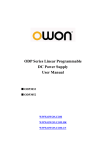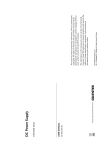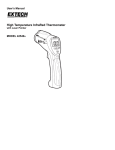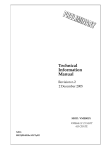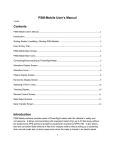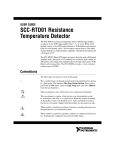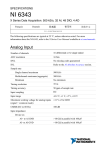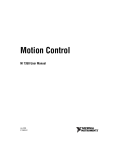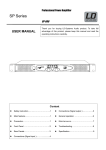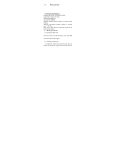Download ODP Series Linear Programmable DC Power Supply User Manual
Transcript
ODP Series Linear Programmable DC Power Supply User Manual ■ ODP3032 ■ ODP3052 99 Washington Street Melrose, MA 02176 Phone 781-665-1400 Toll Free 1-800-517-8431 Visit us at www.TestEquipmentDepot.com May. 2013 edition V1.5.3 Copy Right in this Manual © Lilliput Company. All Rights Reserved. The Lilliput's products are under the protection of the patent rights in America and other countries, including ones which have already obtained the patent rights and those which are applying for. The information in this manual will replace all that in the materials published originally. The information in this manual was correct at the time of printing. However, OWON will continue to improve products and reserves the rights to changes specification at any time without notice. OWON is the registered trademark of the Lilliput Company. 99 Washington Street Melrose, MA 02176 Phone 781-665-1400 Toll Free 1-800-517-8431 Visit us at www.TestEquipmentDepot.com General Warranty Lilliput warrants that the product will be free from defects in materials and workmanship for a period of 2 years (1 year for accessories) from the date of purchase of the product by the original purchaser from the Lilliput Company. This warranty only applies to the original purchaser and is not transferable to the third party. If the product proves defective during the warranty period, Lilliput either will repair the defective product without charge for parts and labor, or will provide a replacement in exchange for the defective product. Parts, modules and replacement products used by Lilliput for warranty work may be new or reconditioned to like new performance. All replaced parts, modules and products become the property of Lilliput. In order to obtain service under this warranty, Customer must notify Lilliput of the defect before the expiration of the warranty period. Customer shall be responsible for packaging and shipping the defective product to the service center designated by Lilliput, and with a copy of customer proof of purchase. This warranty shall not apply to any defect, failure or damage caused by improper use or improper or inadequate maintenance and care. Lilliput shall not be obligated to furnish service under this warranty a) to repair damage resulting from attempts by personnel other than Lilliput representatives to install, repair or service the product; b) to repair damage resulting from improper use or connection to incompatible equipment; c) to repair any damage or malfunction caused by the use of non-Lilliput supplies; or d) to service a product that has been modified or integrated with other products when the effect of such modification or integration increases the time or difficulty of servicing the product. Please contact the nearest Lilliput's Sales and Service Offices for services or a complete copy of the warranty statement. For better after-sales service, please visit our website and register the purchased product online. Excepting the after-sales services provided in this summary or the applicable warranty statements, Lilliput will not offer any guarantee for maintenance definitely declared or hinted, including but not limited to the implied guarantee for marketability and special-purpose acceptability. Lilliput should not take any responsibilities for any indirect, special or consequent damages. Table of Contents 1. General Safety Requirements .......................................................................................... 1 2. Safety Terms and Symbols ............................................................................................... 2 3. General Characteristics ................................................................................................... 3 4. Quick Start ....................................................................................................................... 4 4.1 Front/Rear Panel and User Interface .................................................................................. 5 4.1.1 Front Panel ...................................................................................................................................... 5 4.1.2 Rear Panel ....................................................................................................................................... 7 4.1.3 User Interface .................................................................................................................................. 7 Status Icons .......................................................................................................................................................... 10 4.2 General Inspection............................................................................................................... 11 4.3 Power-On Check .................................................................................................................. 11 4.3.1 AC Power Input Setting ................................................................................................................ 11 4.3.2 Power On ....................................................................................................................................... 12 4.4 Output Inspection ................................................................................................................ 12 4.4.1 Voltage Output Inspection ............................................................................................................. 12 4.4.2 Current Output Inspection ............................................................................................................. 12 4.5 Working Mode ..................................................................................................................... 13 4.5.1 Icons and Ratings .......................................................................................................................... 13 4.5.2 Connections ................................................................................................................................... 13 4.6 System Menu Operation ..................................................................................................... 14 5. Front Panel Operation .................................................................................................. 15 5.1 Turn On/Off the Channel Output ...................................................................................... 16 5.2 Set the Output Voltage/Current ......................................................................................... 16 5.3 Over Voltage/Current Protection....................................................................................... 17 5.3.1 Set O.V.P ....................................................................................................................................... 17 5.3.2 Set O.C.P ....................................................................................................................................... 18 5.4 Timing Output ..................................................................................................................... 18 5.4.1 Enter/Exit Timer Status ................................................................................................................. 18 5.4.2 Timer Setting ................................................................................................................................. 19 5.4.3 Timer Range .................................................................................................................................. 19 5.4.4 Turn On/Off Timing Output .......................................................................................................... 20 5.5 Save/Recall/Record .............................................................................................................. 20 5.5.1 Save System Parameters ................................................................................................................ 20 5.5.2 Recall and Delete System Parameters File .................................................................................... 21 5.5.3 Record the Output ......................................................................................................................... 21 5.6 System Settings .................................................................................................................... 21 i 5.6.1 Set Language ................................................................................................................................. 21 5.6.2 Set Bright....................................................................................................................................... 21 5.6.3 Set Screen Saver Time .................................................................................................................. 21 5.6.4 Set System Time ............................................................................................................................ 22 5.6.5 Buzzer............................................................................................................................................ 22 5.6.6 View System Information.............................................................................................................. 22 5.6.7 Set as Default................................................................................................................................. 22 5.7 Use Built-in Help.................................................................................................................. 23 6. Communication with PC ............................................................................................... 24 7. Troubleshooting ............................................................................................................. 25 8. Technical Specifications ................................................................................................ 26 9. Appendix ........................................................................................................................ 28 9.1 Appendix A: Enclosure ....................................................................................................... 28 9.2 Appendix B: General Care and Cleaning.......................................................................... 28 ii 1.General Safety Requirements 1. General Safety Requirements Before any operations, please read the following safety precautions to avoid any possible bodily injury and prevent this product or any other products connected from damage. In order to avoid any contingent danger, this product is only used within the range specified. Check AC power input setting according to the standards in your own country (see Page 11, "AC Power Input Setting"). Only the qualified technicians can implement the maintenance. To avoid Fire or Personal Injury: Use Proper Power Cord. Use only the power cord supplied with the product and certified to use in your country. Product Grounded. This instrument is grounded through the power cord grounding conductor. To avoid electric shock, the grounding conductor must be grounded. The product must be grounded properly before any connection with its input or output terminal. Check all Terminal Ratings. To avoid fire or shock hazard, check all ratings and markers of this product. Refer to the user's manual for more information about ratings before connecting to the instrument. Do not operate without covers. Do not operate the instrument with covers or panels removed. Use Proper Fuse. Use only the specified type and rating fuse for this instrument. Avoid exposed circuit. Do not touch exposed junctions and components when the instrument is powered. Do not operate if in any doubt. If you suspect damage occurs to the instrument, have it inspected by qualified service personnel before further operations. Use your instrument in a well-ventilated area. Please keep well ventilated and inspect the intake and fan regularly. Do not operate in wet conditions. In order to avoid short circuiting to the interior of the device or electric shock, please do not operate in a humid environment. Do not operate in an explosive atmosphere. In order to avoid damages to the device or personal injuries, it is important to operate the device away from an explosive atmosphere. Keep product surfaces clean and dry. To avoid the influence of dust or moisture in air, please keep the surface of device clean and dry. 1 2.Safety Terms and Symbols 2. Safety Terms and Symbols Safety Terms Terms in this Manual. The following terms may appear in this manual: Warning: Warning indicates the conditions or practices that could result in injury or loss of life. Caution: Caution indicates the conditions or practices that could result in damage to this product or other property. Terms on the Product. The following terms may appear on this product: Danger: It indicates an injury or hazard may immediately happen. Warning: It indicates an injury or hazard may be accessible potentially. Caution: It indicates a potential damage to the instrument or other property might occur. Safety Symbols Symbols on the Product. The following symbol may appear on the product: Hazardous Voltage Refer to Manual Protective Earth Terminal Chassis Ground Public Ground 2 3.General Characteristics 3. General Characteristics OWON ODP Series products are new high-performance programmable linear DC power supplies. The excellent features of this series include up to 100 output groups with configurable timer, high-resolution LCD display, extremely clean ripple and noise, comprehensive over-voltage over-current over-temperature protection, user friendly interface and panel layout, and variety standard interfaces to meet diverse test requirements. Features and benefits: Dual Independent & Separate Control Outputs; Outstanding line regulation rate: ≤0.01%+3mV(voltage), ≤0.1%+3mA(current); Outstanding load regulation rate: ≤0.01%+3mV(voltage), ≤0.2%+3mA(current); Low ripples noise: ≤300 μVrms / 2 mVpp; Four operating mode: independent, parallel connection, series connection, plus-minus; Up to 100 groups time settings; High-precious resolution output; 3.9 inch high resolution (480*320 pixels) TFT LCD display; Interface: USB2.0, RS232. 3 4.Quick Start 4. Quick Start This chapter will deal with the following topics mainly: Front/Rear Panel Overview User Interface Overview How to Implement General Inspection How to Implement Power-On Check How to Implement Output Inspection Instruction of the four Working Mode Instruction of the System Menu Operation 4 4.Quick Start 4.1 Front/Rear Panel and User Interface 4.1.1 Front Panel ③ ② ① ④ ⑤ ⑥ ⑰ ⑦ ⑧ ⑨ ⑯ ⑩ ⑮ ⑬ ⑭ ⑫ ⑪ Figure 4-1 Front panel overview (take ODP3032 for instance) ① LCD Display the user interface ② Numeric keys area Parameter input, include the numeric keys, decimal point and backspace key. ③ Up and down direction key Select menu or change the parameter ④ Enter key Enter menu or confirm the parameter entered ⑤ Knob Select menu or change the parameter, pressing it has the same effect as pressing the enter key ⑥ Left and right direction key Select menu or move the cursor ⑦ System key Enter the system menu ⑧ Timer key Enter/exit timer status ⑨ Help key View the built-in help 5 4.Quick Start ⑩ Channel 2 control Blue Volt/CV key: Set the output voltage of Channel 2 area Blue Curr/CC key: Set the output current of Channel 2 Blue ON/OFF key: Enable/disable the output of Channel 2 ⑪ Output terminals of Channel 2 Channel 2 output connectors ⑫ Mode key Switch the working mode between Independent, Parallel, Series and Plus-minus ⑬ Output terminals of Channel 1 Channel 1 output connectors ⑭ 5V output terminals Output fixed 5V , max output current is 3A (5A for ODP3052) ⑮ Power button Turn on/off the instrument ⑯ Channel 1 control Orange Volt/CV key: Set the output voltage of Channel 1 area Orange Curr/CC key: Set the output current of Channel 1 Orange ON/OFF key: Enable/disable the output of Channel 1 ⑰ Function keys Record key: Record the current output data as a txt file and save to USB disk Recall key: Recall the stored settings file Save key: Save the current setting parameters Set key: Enter/exit the setting interface of timing output Instructions for panel key indicator ON/OFF key: The indicator will be lighted after you turn on the channel. Volt/CV key: The indicator will be lighted when the channel is in Constant Voltage output mode; blinking indicates you are setting the output voltage through the input box. Curr/CC key: The indicator will be lighted when the channel is in Constant Current output mode; blinking indicates you are setting the output current through the input box. 6 4.Quick Start 4.1.2 Rear Panel ① ② ③ ④ ⑥ ⑦ ⑤ Figure 4-2 Rear panel overview ① USB Host port Connect as a "host device" with an external USB device, such as connect a USB disk to the instrument. ② USB Device port Connect as a "slave device" with an external USB device, such as connect the instrument to a PC. ③ COM port Connect the instrument with external equipment as serial port ④ Power socket AC input connector ⑤ Fuse Use the specified fuse according to the voltage scale ⑥ Power switch Switch between 110V and 220V ⑦ Fan Fan inlet 4.1.3 User Interface The below figures are the interfaces in Timer status; you can consult the following instructions for the interfaces in Normal status too. Independent Mode 7 4.Quick Start ④ ⑤⑥ ①② ③ ⑩ ⑦ Channel 1 ⑧ ⑨ Channel 2 (same layout as Channel 1) Figure 4-3 User interface in Independent mode ① Output status of Cannel 1 ② Specified time and left time of current output when the timing output of Channel 1 is on ③ Actual output value of power for Channel 1 ④ Timing output mode of Channel 1 (Sequence / Loop) ⑤ Timer range of Channel 1 ⑥ The parameter number of the current output when the timing output of Channel 1 is on. ⑦ Set values of voltage and current for Channel 1 ⑧ Actual output values of voltage and current for Channel 1 ⑨ Status and set values of O.V.P and O.C.P for Channel 1 in current status ⑩ Status icons, see "Status Icons" on P10 for more details Parallel /Series Mode 8 4.Quick Start ② ① ③ ④ ⑫ ⑤ ⑥ ⑦ ⑧ ⑪ ⑨ ⑩ Figure 4-4 User interface in Parallel/Series mode ① Maximum ratings of voltage and current ② Channel status ③ Output mode of timing output (Sequence / Loop) ④ Timer range ⑤ The parameter number of the current output when the timing output is on ⑥ Specified values of voltage and current ⑦ Specified time of current output when the timing output of is on ⑧ Left time of current output when the timing output of is on ⑨ Specified values of voltage and current that will be output at the next fixed times when the timing output of is on ⑩ Status and set values of O.V.P and O.C.P in current status ⑪ Actual output values of voltage , current and power ⑫ Status icons, see "Status Icons" on P10 for more details Plus-minus Mode 9 4.Quick Start ①② ③ ④ ⑤⑥ ⑩ ⑦ Negative ⑧ ⑨ Positive (same layout as Negative) Figure 4-5 User interface in Plus-minus mode ① Output status of Negative (same as Positive) ② Specified time and left time of current output when the timing output of Negative is on ③ Actual output value of power for Negative ④ Timing output mode of Negative (Sequence / Loop, same as Positive) ⑤ Timer range of Negative (same as Positive) ⑥ The parameter number of the current output when the timing output of Negative is on (same as Positive) ⑦ Set values of voltage and current for Negative ⑧ Actual output values of voltage and current for Negative ⑨ Status and set values of O.V.P and O.C.P for Negative in current status ⑩ Status icons, see "Status Icons" on P10 for more details Status Icons Icons Instruction Connect as a slave device with PC Recording the current output A USB device is detected Current working mode is Independent Current working mode is Parallel 10 4.Quick Start Current working mode is Series Current working mode is Plus-minus The buzzer is on The buzzer is off The system is in Timer Status 4.2 General Inspection After you get a new ODP Series power supply, it is recommended that you should make a check on the instrument according to the following steps: 1. Check whether there is any damage caused by transportation. If it is found that the packaging carton or the foamed plastic protection cushion has suffered serious damage, do not throw it away first till the complete device and its accessories succeed in the electrical and mechanical property tests. 2. Check the Accessories The supplied accessories have been already described in the "Appendix A: Enclosure" of this Manual. You can check whether there is any loss of accessories with reference to this description. If it is found that there is any accessory lost or damaged, please get in touch with the distributor of Lilliput responsible for this service or the Lilliput's local offices. 3. Check the Complete Instrument If it is found that there is damage to the appearance of the instrument, or the instrument can not work normally, or fails in the performance test, please get in touch with the Lilliput's distributor responsible for this business or the Lilliput's local offices. If there is damage to the instrument caused by the transportation, please keep the package. With the transportation department or the Lilliput's distributor responsible for this business informed about it, a repairing or replacement of the instrument will be arranged by the Lilliput. 4.3 Power-On Check 4.3.1 AC Power Input Setting ODP Series adopt 110V/220V AC power source. Users should regulate the voltage scale of the Power Switch according to the standards in their own country (see Figure 4-2) at the rear panel and use an appropriate fuse. 11 4.Quick Start Voltage AC110V AC220V Fuse ODP3032 125 V,F5 A 250 V,F3 A ODP3052 125 V,F10A 250 V,F5A To change the input voltage scale of the instrument, do the following steps: (1) Turn off the power button at the front panel and remove the power cord. (2) Check if the fuse installed before leaving factory (250 V, F3 A) can match with the selected voltage scale; if not, pry the cover open using a straight screwdriver (see ⑤ in Figure 4-2), change the fuse. (3) Regulate the Power Switch to the right voltage scale. 4.3.2 Power On (1) Connect the instrument to the AC supply using the supplied power cord. Warning: To avoid electric shock, the instrument must be grounded properly. (2) Press down the power button at the front panel, the orange and blue key is lighted; the screen shows the boot screen. (3) Press any key to enter. 4.4 Output Inspection Output inspection is to ensure that the instrument can achieve its rated outputs and properly respond to operation from the front panel. For the procedures below, it is suggested that you read "Working Mode" on P13, "Turn On/Off the Channel Output" on P16 and "Set the Output Voltage/Current" on P16. 4.4.1 Voltage Output Inspection The following steps verify basic voltage functions without load: (1) When the instrument is under no load, power on it; make sure that the output current setting value of each working mode is none-zero. (2) Turn on the channel output. The ON/OFF and Volt/CV key is lighted, which indicates the channel you opened is in Constant Voltage output mode. (3) In each working mode, set some different voltage values; check if the actual voltage value displayed is close to the set voltage value, and to check if the actual current value displayed is nearly zero. (4) Check that if the output voltage can be adjusted from zero to the maximum rating. 4.4.2 Current Output Inspection The following steps check basic current functions with a short across the power supply's output: (1) Power on the instrument. (2) Connect a short across (+) and (-) output terminals with an insulated test lead. Use a wire size sufficient to handle the maximum current. 12 4.Quick Start (3) Set the output voltage to the maximum rating. (4) Turn on the channel output. The ON/OFF and Curr/CC key is lighted, which indicates the channel you opened is in Constant Current output mode. (5) In each working mode, set some different current values; check if the actual current value displayed is close to the set current value, and to check if the actual voltage value displayed is nearly zero. (6) Check that if the output current can be adjusted from zero to the maximum rating. (7) Turn off the channel output and remove the short wire from the output terminals. 4.5 Working Mode ODP Series are designed with four working modes: Independent, Parallel, Series and Plus-minus. Press the Mode key to switch between the four working modes. For the instructions of the user interfaces in the four working mode, please see "User Interface" on P7. 4.5.1 Icons and Ratings The status icons and voltage/current ratings of the four mode is listed below. Independent Parallel Series Plus-minus Status Icons Voltage rating 0~30V ODP3032 0.02~3A Current ratings ODP3052 0.02~5A Current ratings 0~30V 0~60V 0~±30V 0.1~6A 0.02~3A 0.02~3A 0.1~10A 0.02~5A 0.02~5A The 5V output terminals always output fixed 5V during the instrument is powered on, the max output current is 3A (ODP3032) or 5A (ODP3052). Users could choose the proper mode and output terminals as required. 4.5.2 Connections Take ODP3032 for instance: Independent 13 4.Quick Start Parallel Series Plus-minus Minus Ground Plus 4.6 System Menu Operation (1) Display the menu Press System key, the System menu is shown on the screen. (2) Choose the menu Press ▲ / ▼ direction key or turn the knob to move around the menu items. Press any one of the < direction key, the key or the knob to enter the submenu; to return to main menu, press the > direction key. In the submenu, press ▲ / ▼ direction key or turn the knob to move around the submenu items. (3) Enter the menu Press the key or the knob to enter the selected menu item. (4) Exit the menu Press System key to close the menu or the pop-up box. Note: In this document, [System → CH1 → O.V.P] means: Enter the CH1 item in System menu, and then choose the O.V.P submenu. 14 5.Front Panel Operation 5. Front Panel Operation This chapter will deal with the following topics mainly: How to Turn On/Off the Channel Output Set the Output Voltage/Current Over Voltage/Current Protection Timing Output Save/Recall/ Record Functions System Settings How to Use Built-in Help 15 5.Front Panel Operation 5.1 Turn On/Off the Channel Output Independent Mode Press the orange ON/OFF key to turn on/off the Channel 1 output. Press the blue ON/OFF key to turn on/off the Channel 2 output. The ON/OFF key is lighted when the corresponding channel is on. Parallel, Series and Plus-minus Mode Press the orange ON/OFF key to turn on/off the channel output. The blue ON/OFF key is invalid. 5.2 Set the Output Voltage/Current You can set the output voltage/current through input box. About the rated range of each mode, please refer to "Icons and Ratings" on P13. Note: The output voltage/current cannot be set in Timer status. If you want to set it, you should exit the Timer status first. Independent mode (1) Press the orange Volt/CV or Curr/CC key, the input box of Channel 1 output voltage/current will pop up. (2) The key light will start blinking, indicating to input, there are two methods to change the value. Modify: Turn the knob or press the ▲ / ▼ direction key to change the value by the unit of cursor position, hold down the ▲ / ▼ direction key to change continuously. Press the < / > key to move the cursor. Input: Use the numeric keys to enter a desired value, the original value will be cleared, and display the value you entered. (3) Press the key to confirm. In the same way, press the blue Volt/CV or Curr/CC key to set the output voltage/current of Channel 2. Parallel/Series mode (1) Press the orange Volt/CV or Curr/CC key, the input box of output voltage/current will pop up. (2) The operation of input box is the same as Independent mode. Plus-minus mode 16 5.Front Panel Operation (1) Press the orange Volt/CV or Curr/CC key, the input box of Negative output voltage/current will pop up. (2) The operation of input box is the same as Independent mode. In the same way, press the blue Volt/CV or Curr/CC key to set the Positive output voltage/current. Note: If the input value is out of the rated range, the box prompts "ERROR"; you need to input another value within the rated range. In Series mode, the minimum rating of the current is 0.1A; in other modes is 0.02A. 5.3 Over Voltage/Current Protection When the Over Voltage Protection (O.V.P) or Over Current Protection (O.C.P) is enabled, once the output voltage/current reaches the set value of O.V.P/O.C.P, the instrument will cut off the output. The value of O.V.P/O.C.P which causes cutting off will turn red and flashing; the instrument will make a buzzing sound if the buzzer is turned on. Note: When the instrument disables the output due to protection, after you make some adjustments, the channel must be restarted to output normally. This function can keep the power output from exceeding the load rating in order to protect the load. The O.V.P/O.C.P can be set separately for the four working mode and for different status (normal, timer). You can enable or disable these functions as required. The parameters of the O.V.P/O.C.P set in normal status take effect in normal status. The parameters of the O.V.P/O.C.P set in timer status take effect in timer status. Note: In Plus-minus mode, if either of the Positive or Negative output voltage/current reaches its own O.V.P/O.C.P, the instrument will disable the output. 5.3.1 Set O.V.P (1) Enter the O.V.P setting menu: Independent Mode Press the System key, enter [System → CH1 (CH2) → O.V.P]. Parallel, Series Mode Press the System key, in normal status, enter [System → O.V.P]; in timer status, enter [System → Pro Set → O.V.P]. Plus-minus Mode Press the System key, enter [System → Positive (Negative) → O.V.P]. (2) A setting box pops up, press the ▲ / ▼ key to switch the state of the O.V.P between 17 5.Front Panel Operation "ON" or "OFF", the O.V.P in current mode and status is enabled or disabled. Note: In Plus-minus mode, the O.V.P status of Positive and Negative will remain consistent, you can set either of them. The O.V.P value can be set separately. (3) Use the numeric keys to enter the O.V.P value in current mode and status. The maximum in Independent, Parallel, Plus-minus mode is 31.5V, the maximum in Series mode is 63V. Press the key to confirm. 5.3.2 Set O.C.P (1) Enter the O.C.P setting menu: Independent Mode Press the System key, enter [System → CH1 (CH2) → O.C.P]. Parallel, Series Mode Press the System key, in normal status, enter [System → O.C.P]; in timer status, enter [System → Pro Set → O.C.P]. Plus-minus Mode Press the System key, enter [System → Positive (Negative) → O.C.P]. (2) A setting box pops up, press the ▲ / ▼ key to switch the state of the O.C.P between "ON" or "OFF", the O.C.P in current mode and status is enabled or disabled. Note: In Plus-minus mode, the O.C.P status of Positive and Negative will remain consistent, you can set either of them. The O.C.P value can be set separately. (3) Use the numeric keys to enter the O.C.P value in current mode and status. The maximum in Independent, Series and Plus-minus mode is 3.15A, the maximum in Parallel mode is 6.3A. Press the key to confirm. 5.4 Timing Output The timing output function can preset up to 100 groups of timing parameters. When you turn on the timing output, the instrument will output the pre-specified voltage, current in pre-specified time. You can set special O.V.P/O.C.P for timer status; see "Over Voltage/Current Protection" for more details. 5.4.1 Enter/Exit Timer Status Press Timer to enter/exit timer status. The icon identifies the system is in timer status. 18 5.Front Panel Operation 5.4.2 Timer Setting Before turning on the timing output, you should set the timer parameters, including voltage, current and output time. This function allows up to 100 groups of timer parameters. In timer status, press the Set key to enter/exit timer setting interface of the current mode. Press the Mode key to switch between the corresponding timer setting interface of the four working mode. Number Voltage Current Output time Editing value Page number Channel 1 (same layout as Channel 2) Channel 2 Figure 5-1 Timer Setting Interface in Independent Mode The selected parameter will be highlighted. In Independent mode or Plus-minus mode, press orange ON/OFF key to select the left parameter area, press blue ON/OFF to select the right parameter area. Press the ▲ / ▼ key to change the parameter item. After selecting the parameter, use the numeric keys to enter a desired value, press the key to confirm. Press the < / > key to go to the previous or next setting page. Note: ● If the input value exceeds the rating of current working mode, the system will change it to the maximum rating automatically after pressing the key to confirm. ● In the Plus-minus mode, the values of the Negative and Positive output time remain consistent, you can set either of them. 5.4.3 Timer Range Timer range setting denotes that you can set the last number of timer parameter group and output mode. You can find out the TimerRng submenu of system menu only in timer 19 5.Front Panel Operation status. If turn on the timing output, the system will output the pre-set parameters between 0 and the set number at sequence or loop mode. (1) In timer status: Independent Mode Press the System key, enter [System → CH1 (CH2) →TimerRng]. Parallel, Series Mode Press the System key, enter [System → TimerRng]. Plus-minus Mode Press the System key, enter [System → Positive →TimerRng]. (2) The timer range setting box pops up. Use the numeric keys enter a number (0~99), press the ▲ / ▼ key to switch between Sequence and Loop, press the key to confirm. 5.4.4 Turn On/Off Timing Output In timer status: Independent Mode Press orange ON/OFF key to turn on/off the timing output of Channel 1. Press blue ON/OFF key to turn on/off the timing output of Channel 2. Parallel, Series or Plus-minus Mode Press orange ON/OFF key to turn on/off the timing output. Note: In the process of timing output, closing the channel output will reset the timer; turning on the channel again will restart the timing output and the timer. 5.5 Save/Recall/Record ODP Series support operations with a USB flash device and local file storage, including: store, recall and delete current setting parameters. The current data of the channel can be recorded into a txt file, which stored in USB disk. You can connect the USB disk to the ① USB Host interface in Figure 4-2. After connecting the USB disk successfully, an icon will be shown at the top of the screen. 5.5.1 Save System Parameters In Normal Status, press the Save key to save the parameters about current working mode and the output voltage/current, the O.V.P/O.C.P of current mode. You can name the setting files. This function is not available in Timer Status. (1) In Normal Status, press the Save key to enter the function interface (press it again to exit). Press the ▲ / ▼ key to choose the storage location as "Local" or "UDisk". Turn 20 5.Front Panel Operation the knob to change the selected character in "Save name" input box. Press the > key to add the next character. Press the < key to select the previous character. Press the ← key to delete the selected character. (2) Press the key to store after editing the file name. 5.5.2 Recall and Delete System Parameters File (1) Press the Recall key to enter the function interface (press it again to exit). Press the ▲ / ▼ key to choose the storage location. Press the key to show the list of system parameters files. (2) The list displays the file name and stored date. Turn the knob or press the ▲ / ▼ key to select a file, and then press the key. (3) Two options appear on the screen: "Load" and "Delete". Turn the knob or press the < / > key to switch between the options. Press the key to confirm. 5.5.3 Record the Output You have to insert a USB disk before using this function. By pressing the Record key, the current data of the channel can be recorded into a txt file, which stored in USB disk. (1) Press the Record key; press the numeric keys to set the interval. (2) Press the key to start recording. During recording, an icon status bar. (3) Press the Record key again to stop recording. is shown on the 5.6 System Settings You can set the system by operating the System Menu. It is suggested that you should read the "System Menu Operation" on P14 first, so as to be familiar with the menu operation. 5.6.1 Set Language Press the System key and enter [System →Language]; choose the desired language. The supported languages include: Chinese, English and so on. 5.6.2 Set Bright Press the System key and enter [System →Display →Bright]. Press the < / > key or turn the knob to adjust the screen brightness (1~10). 5.6.3 Set Screen Saver Time The screen saver will run automatically if no operation is taken for any key within the set time. Press any key to resume. Press the System key and enter [System →Display →ScrSaver]. Press the < / > key or turn the knob to adjust the screen saver time (1~99 minutes). When it is set to "00", the screen saver is disabled. 21 5.Front Panel Operation 5.6.4 Set System Time Press the System key and enter [System →Sys Set →SysTime]. Press the ▲ / ▼ key or turn the knob to set the selected value. Press the < / > key to move the cursor. Press the key to confirm. 5.6.5 Buzzer Press the System key and enter [System →Sys Set →Buzzer]. Press the key to turn on/off the buzzer. When the buzzer is on, an icon will be shown on the status bar. You will hear a key tone once a key is pressed down; when the system prompts the instrument will make a buzzing sound, e.g. cutting off the output due to O.V.P/O.C.P. When the buzzer is off, an icon will be shown on the status bar. 5.6.6 View System Information Press the System key and enter [System →SysInfo]. You can view the Serial Number, Software Version and Hardware Version. 5.6.7 Set as Default Press the System key and choose [System →Default], press the key to use the factory defaults, see table below. Working Mode Parameter CH 1 CH 2 Voltage 5V 5V Parallel Series Plus-minus Negative Positive 12 V 15 V 12 V 12 V Current 0.5 A 0.5 A 1A 1.5 A 0.5 A 0.5 A O.V.P value 5.5 V 5.5 V 12.5 V 15.5 V 12.5 V 12.5 V O.C.P value 0.6 A 0.6 A 1.1 A 1.6 A 0.6 A 0.6 A O.V.P/O.C.P status OFF OFF OFF OFF OFF OFF O.V.P value 15 V 15 V 12 V 24 V 12 V 12 V O.C.P value 1.5 A 1.5 A 1.5 A 1.5 A 0.5 A 0.5 A OFF OFF OFF OFF OFF Normal status Timer status Independent O.V.P/O.C.P status Menu Item Defaults Brightness 9 Screen Saver OFF Buzzer ON OFF 22 5.Front Panel Operation 5.7 Use Built-in Help (1) Press Help function button, the catalog will display in the screen. (2) Press the ▲ / ▼ key or turn the knob to choose help topic. (3) Press the key to view the details about the topic; press the the catalog. (4) Press Help again to exit the help, or just do other operations. 23 ← key to go back to 6.Communication with PC 6. Communication with PC ODP Series Power Supply supports communications with a PC through USB or COM interface. You can use the ODP communication software to set the parameters, control the output of the power supply, and synchronously display the actual output values on the Power Supply screen. (1) Install the software Install the ODP communication software on the supplied CD. (2) Connect the instruments Use a USB data cable to connect the USB Device port in the rear panel of the Power Supply to the USB port of a PC. Or use a data cable to connect the COM port in the rear panel of the Power Supply to the COM interface of a PC. (3) Install the driver When the Power Supply is turned on, a dialog will appear on the PC screen and guide you to install the USB driver. The driver is in the "USBDRV" folder under the directory where the ODP communication software is installed, such as "C:\Program Files\ODP\USBDRV". (4) Use the software Run the ODP software; click the "Menu" button in the top right corner. Choose the "Communications → Ports-Settings" to set the corresponding communication parameters. After connect successfully, the connection information in the bottom right corner of the software will turn green. To learn about how to operate the software, you can choose "Communications → Help → Help" to open the help file. Figure 6-1: The Power Supply connects with PC successfully 24 7.Troubleshooting 7. Troubleshooting 1. The instrument is powered on but no Display. Check if the power is connected properly. Check if the Power Switch is in the proper voltage scale. Check if the fuse which is below the AC Power socket is used appropriately and in good condition (the cover can be pried open with a straight screwdriver). Restart the instrument after the steps above. If the problem still exists, please contact Lilliput for our service. 2. The output is abnormal: Check if the output voltage is set to 0V. If so, set it to other value. Check if the output current is set to 0A. If so, set it to other value. When in timer status, check if there is any voltage/current value of timer setting is set to 0. If so, set it to other value. If the problem still exists, please contact Lilliput for our service. 3. Cannot identify the USB device correctly: Check if the USB device is in good condition. Check if the used USB device is a flash device, note a hard disk cannot be supported. Restart the instrument and insert your USB flash device again. If the problem still exists, please contact Lilliput for our service. 25 8.Technical Specifications 8. Technical Specifications The specifications below are based on the instrument having run for at least 30 minutes continuously under the specified operating temperature. Channel 1/Channel 2 Independent/Parallel 0~30V Voltage Series 0~60V Plus-minus -30V~30V Independent/Series 0~3A /Plus-minus ODP3032 DC Output Ratings Parallel 0~6A Current Independent/Series 0~5A /Plus-minus ODP3052 Parallel 0~10A Line Regulation Load Regulation Noise and Ripple (20Hz~7MHz) Settings Resolution Settings Accuracy (25℃±5℃) Read Back Resolution CV ≤0.01% + 3mV CC ≤0.1% + 3mA CV ≤0.01% + 3mV CC ≤0.2% + 3mA Fixed 5V 5V 3A 5A ≤3mV ≤0.1%+3mV ≤300 μVrms / 2 mVpp CV ≤300 μVrms / 2 mVpp CC ≤3mArms Voltage 1mV None Current 1mA None Voltage ≤0.05% + 3mV None Current ≤0.1% + 3mA 1mV (<10V) 10mV (≥10V) None 1mA None ≤0.05% + 3 digits None ≤0.1% + 3 digits None Voltage Current Read Back Accuracy Voltage (25℃±5℃) Current 26 None 8.Technical Specifications Display Display Type Display Resolution Display Colors 3.9 inch colored LCD (Liquid Crystal Display) 480 (Horizontal) × 320 (Vertical) Pixels 65536 colors, TFT screen Power Supply Fuse 110 Vac ± 10%, 220 Vac ± 10%; AC input 50/60Hz 110V 125 V,F5A ODP3032 220V 250 V,F3A 110V 125 V,F10A ODP3052 220V 250 V,F5A Environment Working temperature: 0℃~40℃ Storage temperature: -20℃~60℃ ≤ 90% Operating: 3,000 m Non-operating: 15,000 m Fan cooling Temperature Relative Humidity Height Cooling Method Mechanical Specifications Dimension 298mm×202mm×450mm (W*H*D) Weight About 9.8 kg Interval Period of Adjustment: One year is recommended for the calibration interval period. 27 9.Appendix 9. Appendix 9.1 Appendix A: Enclosure Standard Accessories: A power cord that fits the standard of the destination country A USB data cable A CD (PC link application software) A User Manual 9.2 Appendix B: General Care and Cleaning General Care Do not store or leave the instrument where the liquid crystal display will be exposed to direct sunlight for long periods of time. Caution: To avoid any damage to the instrument, do not exposed it to any sprays, liquids, or solvents. Cleaning Inspect the instrument as often as operating conditions require. To clean the instrument exterior, perform the following steps: 1. Wipe the dust from the instrument surface with a soft cloth. Do not make any scuffing on the transparent LCD protection screen when clean the LCD screen. 2. Disconnect power before cleaning your instrument. Clean the instrument with a wet soft cloth not dripping water. It is recommended to scrub with soft detergent or fresh water. To avoid damage to the instrument, do not use any corrosive chemical cleaning agent. Warning: Before power on again for operation, it is required to confirm that the instrument has already been dried completely, avoiding any electrical short circuit or bodily injury resulting form the moisture. 99 Washington Street Melrose, MA 02176 Phone 781-665-1400 Toll Free 1-800-517-8431 Visit us at www.TestEquipmentDepot.com 28

































